|
|
|
Sort Order |
|
|
|
Items / Page
|
|
|
|
|
|
|
| Srl | Item |
| 1 |
ID:
159899


|
|
|
|
|
| Summary/Abstract |
Al Qaeda leaders have consistently praised the Chechen insurgents as an exemplary front of global jihad. Ayman al-Zawahiri recently applauded the steadfastness of the Chechen rebels and indicated that their resolve for jihad is worthy of emulation. Ever since the world found out about a war going on in the Muslim republic in the North Caucasus, Al Qaeda leadership has attempted to represent the Chechen struggle as one of its own battlefields. In turn, the Russian government has tried to justify its policies in the North Caucasus through demonstrating to the world that the Kremlin is fighting nothing less than Osama bin Laden’s agents in Chechnya. The North Caucasus insurgents in turn have embraced some of Al Qaeda’s narratives. While such narratives have proliferated, the factual evidence to show the direct links between the North Caucasus insurgents and Al Qaeda is still lacking. The article examines how terrorist groups such as Al Qaeda use framing for strategic ends. The evidence discussed here suggests that Al Qaeda, the North Caucasus insurgents, and the Russian government have adopted similar narratives. However, the lack of evidence to back up such narratives indicates the differences in reasons driving the convergence of the narratives.
|
|
|
|
|
|
|
|
|
|
|
|
|
|
|
|
| 2 |
ID:
159888
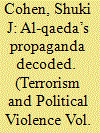

|
|
|
|
|
| Summary/Abstract |
We describe a novel hybrid method of content analysis that combines the speed of computerized text analysis with the contextual sensitivity of human raters, and apply it to speeches that were given by major leaders of Al-Qaeda (AQ)—both in its “core” Afghanistan/Pakistan region and its affiliate group in Iraq. The proposed “Ideology Extraction using Linguistic Extremization” (IELEX) categorization method has acceptable levels of inter-rater and test-retest reliabilities. The method uncovered subtle (and potentially non-conscious) differences in the emphases that Usama Bin Laden and Ayman Al-Zawahiri put on the various components of their ideological justification for terrorism. We show how these differences were independently recognized as the crux of the rift in AQ, based on documents that were confiscated in Abbottabad following Usama Bin Laden’s assassination. Additionally, several of the ideological discrepancies that we detected between AQ “core” and its Iraqi affiliate correspond to schisms that presumably led to the splintering of AQ Iraq and the rise of ISIS. We discuss IELEX’s capability to quantify a variety of grievance-based terrorist ideologies, along with its use towards more focused and efficient counter-terrorism and counter-messaging policies.
|
|
|
|
|
|
|
|
|
|
|
|
|
|
|
|
| 3 |
ID:
159881
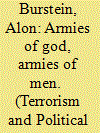

|
|
|
|
|
| Summary/Abstract |
This article compares the violent activity of secular and religious terror organizations. Utilizing data compiled by the Global Terrorism Database cross-referenced with secondary and primary sources regarding the degree of religious components embedded in organizations’ ideologies, it tests the violent patterns of activity carried out by organizations guided by predominantly secular, secular/religious, and religious ideologies, between the years 1970 and 2012. The findings confirm that a) religious ideology correlates with specific, more deadly, attack tactics and violent patterns; and b) the degree of religious components within terror organizational ideology should be tested along a spectrum: the more religious an organization is, the more attacks it tends to carry out, and the deadlier its attacks become.
|
|
|
|
|
|
|
|
|
|
|
|
|
|
|
|
| 4 |
ID:
159898
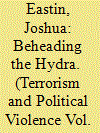

|
|
|
|
|
| Summary/Abstract |
We evaluate the effectiveness of anti-insurgent violence as a means to suppress insurgency with micro-level data from the Iraq War. Our findings suggest that while violence against insurgents increases the incidence of future insurgent attacks, the intensity of this violence can significantly influence the outcome. Rather than shifting monotonically, the effect is actually curvilinear, first rising, and then contracting. We argue that at low to moderate levels, violence against insurgents creates opportunities for these groups to signal strength and resolve, which enables them to build momentum, heighten civilian cooperation, and diminish political support for counterinsurgency efforts in these forces’ home countries. The result is an escalation in insurgent attacks. However, at higher levels, this effect should plateau and taper off as insurgent attrition rises, and as civilian fears over personal safety displace grievances that might otherwise provoke counter-mobilization. Our empirical tests on data from the Iraq War, 2004–2009, demonstrate robust support for this argument.
|
|
|
|
|
|
|
|
|
|
|
|
|
|
|
|
| 5 |
ID:
159903
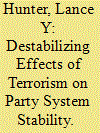

|
|
|
|
|
| Summary/Abstract |
In democracies with stable party systems, voters can more easily trace policy decisions from parties and representatives within the government to specific policy outcomes. Consequently, party system stability (PSS) has been reportedly linked to a variety of factors including economic conditions, democratic performance, political institutions, and socioeconomic cleavages. While informative, these lessons offer precious little insight into other factors that can destabilize a party system. In this work, we surmise that terrorist attacks have important implications for two commonly used measures of PSS. The results of a pooled, cross-sectional time series analysis confirm our hypothesis: deadly attacks proximate to elections destabilize party systems, even when controlling for multiple standard controls. In addition, the level of democratic consolidation within states also influences the degree that fatal terrorist attacks affect party system stability. These findings are based on terrorism data collected from the Global Terrorism Database and from PSS data compiled by the authors.
|
|
|
|
|
|
|
|
|
|
|
|
|
|
|
|
| 6 |
ID:
159900
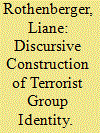

|
|
|
|
|
| Summary/Abstract |
The media coverage of terrorist acts has been the subject of numerous scientific studies. However, the terrorist groups’ own communication perspectives have not been thoroughly researched. The following article deals with terrorist groups and their use of websites for identity building. We examine the discursive construction of terrorist group identity through critical discourse analysis (CDA). The CDA of online texts from websites of terrorist groups is based on a five macro-strategy scheme. Our sample consists of six terrorist groups, with each group of two sharing different motivations: social-revolutionary, ethno-nationalist, or religious. All the groups analyzed are listed as terrorist organizations by the European Union. The CDA of 27 terrorist websites, purposively sampled, was conducted using two coders per site. Through this analysis, the researchers draw conclusions on strategies employed by terrorist organizations in building identity and how to counter their unregulated propaganda.
|
|
|
|
|
|
|
|
|
|
|
|
|
|
|
|
| 7 |
ID:
159887


|
|
|
|
|
| Summary/Abstract |
This research investigates the development and expansion of the al-Shabaab movement in Somalia from 2000 to 2013. Initially a marginal player in Somalia, by 2013 al-Shabaab had transformed into the most formidable armed opposition to challenge the nascent Somali government and its allies. During this time period they administered territory domestically, while expanding their tactical repertoire and geographic scope of attacks. After analyzing the historical conditions (2000–2006) from which al-Shabaab emerged, I explore the evolution of this organization through the use of historical process tracing. This entails looking for critical junctures on a global, national, and local level that had a dramatic impact on the future trajectory of the insurgency. The results show that harsh foreign interventions had many deleterious consequences, acting as an initial impetus for armed resistance, while also acting as a continuous source of controversy which al-Shabaab exploited to gain new recruits. Moreover, irreconcilable intra-organizational schisms also contributed to altering the future organizational decisions made by al-Shabaab. The culmination of these results engage and expand the theory of categorical terrorism, offering observations to help scholars and policy makers alike begin to re-conceptualize ways to study terrorism and political violence.
|
|
|
|
|
|
|
|
|
|
|
|
|
|
|
|
| 8 |
ID:
159902


|
|
|
|
|
| Summary/Abstract |
This article studies whether the action-reaction model holds on an “embryonic” terrorist group like Galician Resistance (REGA). After presenting an overview of REGA’s history, structure, financing, terrorist campaigns, and the police measures adopted against them, the text empirically contrasts whether deterrence is an efficient measure in reducing an incipient terrorist group’s actions. Our results show that deterrence does in fact reduce the number of attacks when aimed at the group’s periphery. However, it causes a backlash of new attacks when aimed at the group’s core. In addition, we prove that an increase in the number of attacks also causes a reaction by police forces and a higher number of detentions of core members. Our results give some meaningful insights into the design of counter-terrorism strategies aimed against “embryonic” groups.
|
|
|
|
|
|
|
|
|
|
|
|
|
|
|
|
| 9 |
ID:
159884


|
|
|
|
|
| Summary/Abstract |
This article attempts to provide insights into selected features of Pakistan’s most wanted terrorists using a dataset of 895 high-profile terrorists provided by the Counter Terrorism Wings of the Criminal Investigation Departments of regional police offices of Pakistan. It identifies spatial patterns of terrorist supply at subnational levels. The educational background of terrorists has also been analyzed. Noteworthy variations are observed in the supply of different types of terrorists across the geographical landscape of Pakistan. Findings also reveal that though terrorists are relatively more educated than the population group they emerge from, there is a higher probability of them emerging in districts with lower socio-economic performance.
|
|
|
|
|
|
|
|
|
|
|
|
|
|
|
|
| 10 |
ID:
159883


|
|
|
|
|
| Summary/Abstract |
This study investigates the absence of substantive linkages between locally based Salafi Jihadist movements and their more transnational counterparts such as Al-Qaeda or ISIS. While studies have addressed the heterogeneity in Jihadi alliances, the question of why inter-Jihadi ties are completely absent or tenuous at times is under-theorized in the literature. Given ISIS’s recent inexorable advance through the Middle East and North Africa and its ever-growing ties with local Jihadists, it is timely to investigate under what conditions locally based militant Islamists are less likely to forge ties with global Jihadists. Using the Allied Democratic Forces (ADF)—a militant Islamist group in the Ugandan-Congolese borderland—as an illustrative case study, the research sheds light on conditions under which inter-Jihadi ties are less likely. These include the extent of ideological divergence between local and global Jihadists, the degree of relevance to the local community, and the fear of attracting new enemies in the form of more stringent counter-terrorism operations.
|
|
|
|
|
|
|
|
|
|
|
|
|
|
|
|
| 11 |
ID:
159904
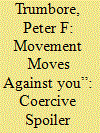

|
|
|
|
|
| Summary/Abstract |
More than a decade on, the Northern Ireland peace process can largely be considered a success. Despite the failure of the Provisional Republican Movement to achieve a united Ireland free of British control, the large-scale violence of “The Troubles” has been relegated to the past. Applying the logic of coercive diplomacy, this study examines the role of threats and the use of selective and limited violence by the Provisional Movement to manage real and potential opponents and challengers that have emerged within its own ideological ranks to maintain its position of dominance and prevent a spoiling of the peace process. This study shows that the Provisional Movement retained the capability to employ violence and demonstrated the credibility of coercive threat through a willingness to use force against its opponents on the Republican spectrum, and was able to do so with a high degree of impunity.
|
|
|
|
|
|
|
|
|
|
|
|
|
|
|
|
| 12 |
ID:
159890
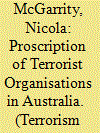

|
|
|
|
|
| Summary/Abstract |
Australia has a long history of legislation enabling the proscription of organisations which pose a threat to Australian security. Such laws are by no means a post-9/11 phenomenon. However, the proscription of organisations has assumed a particularly significant place in this country’s legislative response to the threat of terrorism since the terrorist attacks in New York and Washington. The focus of this article is upon the provisions of Division 102 of the Criminal Code Act 1995 (Cth), as it is this regime which has been most commonly relied upon in practice. Whilst the nature of the threat of terrorism faced by Australia has moved through several distinct phases, the basic structure of this regime has remained substantially intact. For that reason, although this article will canvass recent legislative amendments made in response to the foreign terrorist fighters phenomenon specifically, the aim is to provide a holistic picture of the form and substance of the proscription regime in Division 102. This builds upon the pre-existing scholarship in the field by carefully analysing the lessons which can be drawn from the now quite significant number of prosecutions for terrorist organisation offences.
|
|
|
|
|
|
|
|
|
|
|
|
|
|
|
|
| 13 |
ID:
159889
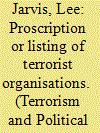

|
|
|
|
|
| Summary/Abstract |
This article serves as an introduction to this Special Issue on the banning or proscription of terrorist organisations around the world. It begins by arguing for greater attention to proscription powers because of their contemporary ubiquity, considerable historical lineage, implications for political life, and ambiguous effectiveness. Following an overview of the Issue’s questions and ambitions, the article discusses five themes: key moments of continuity and change within proscription regimes around the world; the significance of domestic political and legal contexts and institutions; the value of this power in countering terrorism and beyond; a range of prominent criticisms of proscription, including around civil liberties; and the significance of language and other symbolic practices in the justification and extension of proscription powers. We conclude by sketching the arguments and contributions of the subsequent articles in this Issue.
|
|
|
|
|
|
|
|
|
|
|
|
|
|
|
|
| 14 |
ID:
159896
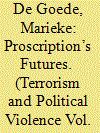

|
|
|
|
|
| Summary/Abstract |
Proscription of individuals and groups potentially linked to terrorism in the form of targeted sanctions have become increasingly controversial in recent years, especially in Europe. Initially considered the less violent alternative when countering terrorism, individual proscriptions have become contested for their impact on due process rights and democratic space. This paper focuses on a key aspect of proscription measures that goes relatively unnoticed: its discourses and practices of time and temporality. It analyses in some depth the rationalities of time evoked, debated, accepted, and rejected in two court cases on individual sanctions. It focuses on two elements at work in these cases: first, the relation between the precautionary and the punitive; second, the politics of establishing and examining terrorist intention. In this manner, it contributes to broader literatures on proscription in two ways. First, it advances the debate on security temporalities in general and the discussion of future-oriented sanctions in particular, by focusing on recent cases and case-law. Second, the paper brings a focus on legal practice to proscription debates. The paper concludes that the juridical repertoire of establishing and assessing intentions is not just broadened but fundamentally altered in the current proscription regime.
|
|
|
|
|
|
|
|
|
|
|
|
|
|
|
|
| 15 |
ID:
159885
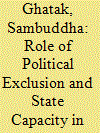

|
|
|
|
|
| Summary/Abstract |
Extant literature on intrastate conflict independently explores terrorism and civil war. However, both terrorism and civil war are probably parts of a continuum of intrastate conflict with the former at one end and the latter at the other end in terms of intensity. I argue that two factors play important roles in rebels’ decision-making calculus, namely, the size of their support base and state strength. Terrorism, as a strategy of the weak, is optimal when the rebel groups have little support among their audience and the state is strong. On the other hand, guerrilla warfare is an ideal strategy when such groups have a greater support base and the state is weak. The theoretical argument is tested on a dataset of Myanmar and six countries of South Asia and for 1970–2007.
|
|
|
|
|
|
|
|
|
|
|
|
|
|
|
|
| 16 |
ID:
159895
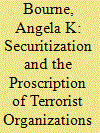

|
|
|
|
|
| Summary/Abstract |
This article applies securitization theory to account for the proscription of organizations linked to Euskadi Ta Askatasuna (ETA) in Spain. I argue that securitization is vital for understanding the evolution of Spanish counterterrorism policy from tolerating to banning political organisations not directly involved in terrorist attacks, but supporting and sympathetic to ETA. More specifically, I examine the role of the judiciary in the initiation of securitization processes in which ETA came to be conceived as a “complex structure” integrating armed and unarmed activists, and the resonance of judicial securitization frames in the public sphere. I do so by analysing evolving conceptions of the relationship between ETA and two organizations—the youth group Jarrai and its successors Haika and Segi and the ETA prisoners’ lobby Gestoras proAmnistía and its successor Alkatasuna—as articulated in court rulings and a sample of 573 newspaper articles published in the Spanish daily El País between 1994 and 2016. I argue that two modes of securitization can be observed in these cases, one extending security threats posed by ETA’s terrorist strategy to the political organizations and one framing both the terrorist group and political organizations as threats to the democratic community.
|
|
|
|
|
|
|
|
|
|
|
|
|
|
|
|
| 17 |
ID:
159886
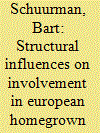

|
|
|
|
|
| Summary/Abstract |
This article empirically assesses the applicability of structural-level hypotheses for involvement in terrorism within the context of European homegrown jihadism. It uses these hypotheses to study how structural factors influenced involvement in the Dutch “Hofstadgroup.” Structural factors enabled the group’s emergence and its participants’ adoption of extremist views. They also motivated involvement in political violence and a shift in some participants’ focus from joining Islamist insurgents overseas to committing terrorism in the Netherlands. Finally, structural factors precipitated an actual terrorist attack. No support is found for the frequently encountered argument that discrimination and exclusion drive involvement in European homegrown jihadism. Instead, geopolitical grievances were prime drivers of this process.
|
|
|
|
|
|
|
|
|
|
|
|
|
|
|
|
| 18 |
ID:
159893
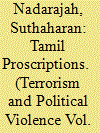

|
|
|
|
|
| Summary/Abstract |
Conventional analyses of terrorism proscription rely on conceptions of policy in terms of bureaucratic institutions and processes functioning according to means-end rationality, and law as an institutionalised body of rules expressive of sovereign power. By contrast, this article argues that the workings of Western terrorism proscription are inseparable from and deeply conditioned by situated interpretations of the contexts and dynamics within which West-led interventions for global stability—equated with liberal order—are pursued. Predicated on a seemingly self-evident division between “liberal” conduct, actors, and practices and illiberal ones which threaten the former, the production of good order requires the strengthening of the former, and the disciplining, transformation, or destruction of the latter. However, categorisations as “liberal” or “non-liberal” are not derived from “objective” criteria, but always mutually dependent on the situated interpretations by (self-recognised) liberals of the contexts within which they are intervening. Taking an interpretive approach that treats state action as situated practice, the article traces Western states’ security engagement with Sri Lanka before, during, and after the armed conflict (1983–2009) to show how changing calculations for liberal peace there governed evolving proscription practices in relation to the LTTE and the Tamil diaspora.
|
|
|
|
|
|
|
|
|
|
|
|
|
|
|
|
| 19 |
ID:
159901
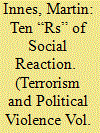

|
|
|
|
|
| Summary/Abstract |
This article provides a case study analysis of social reactions to the murder of Fusilier Lee Rigby in 2013. Informed by empirical data collected by systematic monitoring of social media platforms, the analysis identifies a number of online behaviours with offline effects—labeled the ten “Rs”—that collectively constitute the process of social reaction to the crime. These are defined as: reporting; requesting; responding; recruiting; “risking”; retaliating; rumouring; remembering; reheating; and “resiliencing”. It is argued that the ability to observe these behaviours through the application of qualitative social media analysis has considerable potential. Conceptually, the analysis provides new insight into the complex and chaotic processes of sense-making and meaning attribution that arise in the aftermath of terrorist attacks. It illuminates how patterns of social reaction on social media are nuanced and complicated, with different segments of the public interpreting the same developments very differently. In addition, the findings and the conceptual framework outlined have implications for policy and practice development in terms of establishing a more effective and evidence-based approach to the consequence management of “post-event” conflict dynamics and social reactions.
|
|
|
|
|
|
|
|
|
|
|
|
|
|
|
|
| 20 |
ID:
159897
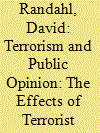

|
|
|
|
|
| Summary/Abstract |
This article uses a large-n dataset to investigate the effect of terrorist attacks with American victims on the popularity of the U.S. president. The study uses two broad theoretical frameworks to analyze this effect, the score-keeping framework and the rally-effect framework. The findings of the study show that, when excluding the effect from the September 11, 2001 terrorist attacks, actual terrorist attacks have no generalizable short-term impact on the popularity of the U.S. president. This indicates that even though the topics of national security, terrorism, and the president’s ability to handle these issues are important in the political debate in the United States, actual terrorism has little or no short-term impact on presidential approval ratings.
|
|
|
|
|
|
|
|
|
|
|
|
|
|
|
|
|
|
|
|
|